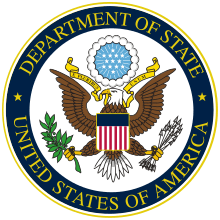Bureau of Educational and Cultural Affairs
The Bureau of Educational and Cultural Affairs (ECA) of the United States Department of State fosters mutual understanding between the people of the United States and the people of other countries around the world. It is responsible for the United States Cultural Exchange Programs.
 Seal of the United States Department of State | |
| Bureau overview | |
|---|---|
| Formed | 1961 |
| Preceding bureau |
|
| Jurisdiction | Executive branch of the United States |
| Headquarters | Harry S. Truman Building, Washington, D.C., United States |
| Employees | 455 (as of 2011)[1] |
| Annual budget | $634 million (FY 2017)[2] |
| Bureau executive | |
| Parent department | U.S. Department of State |
| Website | www |
The current Assistant Secretary of State for Educational and Cultural Affairs is Marie Royce.[3]
History
In 1940, Nelson Rockefeller began the exchange of persons program with Latin America, as the Coordinator of Commercial and Cultural Affairs for the American Republics. This program sent 130 journalists from Latin America to the United States.
In 1942, The United States Office of War Information (OWI) was created out of the United States Government's need for a centralized location for information. OWI was disbanded under the Truman administration, though a small element of the original structure was maintained within the State Department as the Office of International Information and Cultural Affairs (OIC), which was renamed the Office of International Information and Educational Exchange.
In 1948, the Smith-Mundt Act sought to "promote a better understanding of the United States in other countries, and to increase mutual understanding." The educational and cultural exchange aspects of the State Department were removed from the Bureau of Public Affairs and entered the newly created Bureau of Educational and Cultural Relations (CU) in 1959.[4]
In 1961, Congress passed the Fulbright-Hays Act to establish a program to “strengthen the ties which unite us with other nations by demonstrating the educational and cultural interests, developments, and achievements of the people of the United States and other nations”.[5] In 1978, the United States International Communication Agency (USICA) absorbed the bureau with the understanding that USICA was in charge of United States public diplomacy. Ronald Reagan renamed USICA to the United States Information Agency in 1982, and in 1999, USIA was absorbed by the State Department.[6]
Programs
- Alumni TIES (Thematic International Exchange Seminars)
- Congress-Bundestag Youth Exchange
- Cultural Heritage Center
- Edmund S. Muskie Graduate Fellowship Program (the program was cancelled in 2013)
- EducationUSA[7]
- English Teaching Forum: A Journal for the Teacher of English Outside the United States
- Fulbright Scholarship
- Future Leaders Exchange (FLEX)
- Gilman Program[8]
- Hubert Humphrey Fellowship
- International Visitor Leadership Program
- TechWomen
- Youth Exchange and Study (YES)
- The Stevens Initiative
- Teachers of Critical Languages Program (TCLP)
- CLS Program
See also
References
- "Inspection of the Bureau of Educational and Cultural Affairs" (PDF). Inspector General of the Department of State. February 2012. Retrieved April 1, 2016.
- "FY 2019 Congressional Budget Justification - Department of State, Foreign Operations, and Related Programs" (PDF). U.S. Department of State. February 12, 2018. Archived from the original (PDF) on February 12, 2018. Retrieved February 24, 2018.
- Marie Royce Sworn In as Assistant Secretary of State for Educational and Cultural Affairs
- "History and Mission of ECA". U.S. Department of State. Retrieved December 10, 2015.
- https://www2.ed.gov/about/offices/list/ope/iegps/fulbrighthaysact.pdf
- "History of the Bureau of Educational and Cultural Affairs". Retrieved April 27, 2011.
- "EducationUSA". Archived from the original on June 30, 2007. Retrieved June 22, 2007.
- "Archived copy". Archived from the original on June 30, 2007. Retrieved June 24, 2007.CS1 maint: archived copy as title (link)